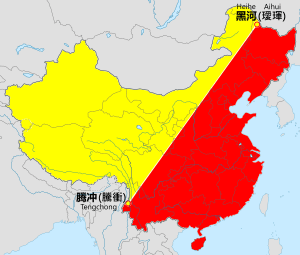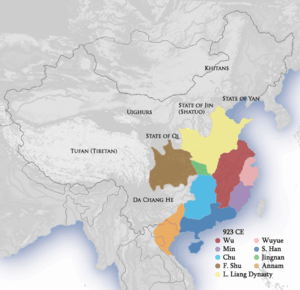Ethnic issues in China
Ethnic issues in China arise from Chinese history, nationalism, and other factors. They have driven historical movements such as the Red Turban Rebellion (which targeted the Mongol leadership of the Yuan Dynasty) and the Xinhai Revolution, which overthrew the Manchu Qing Dynasty. Ethnic tensions have led to incidents in the country such as the July 2009 Ürümqi riots.
Background
China is a largely homogenous society; over 90% of its population has historically been Han Chinese.[1] Some of the country's ethnic groups are distinguishable by physical appearance and relatively-low intermarriage rates. Others have married Han Chinese and resemble them. A growing number of ethnic minorities are fluent at a native level in Mandarin Chinese. Children sometimes receive ethnic-minority status at birth if one of their parents belongs to an ethnic minority, even if their ancestry is predominantly Han Chinese. Pockets of immigrants and foreign residents exist in some cities.
A 100-day crackdown on illegal foreigners in Beijing began in May 2012, with Beijing residents wary of foreign nationals due to recent crimes.[2][3] China Central Television host Yang Rui said, controversially, that "foreign trash" should be cleaned out of the capital.[2]
.png)
China is the most populated country in the world and its national population density (137/km2) is similar to those of Switzerland and the Czech Republic. The overall population density of China conceals major regional variations, the western and northern part have a few million people, while eastern half has about 1.3 billion. The vast majority of China's population lives near the east in major cities.
In the 11 provinces, special municipalities, and autonomous regions along the southeast coast, population density was 320.6 people per km2.
Broadly speaking, the population was concentrated east of the mountains and south of the northern steppe. The most densely populated areas included the Yangtze River Valley (of which the delta region was the most populous), Sichuan Basin, North China Plain, Pearl River Delta, and the industrial area around the city of Shenyang in the northeast.
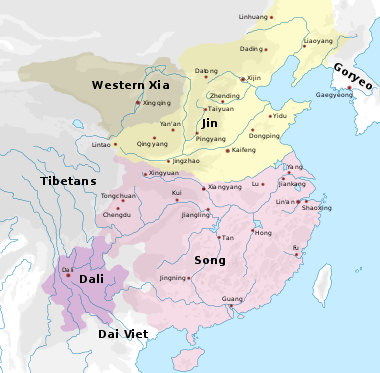
Population is most sparse in the mountainous, desert, and grassland regions of the northwest and southwest. In Inner Mongolia Autonomous Region, portions are completely uninhabited, and only a few sections have populations denser than ten people per km2. The Inner Mongolia, Xinjiang, and Tibet autonomous regions and Qinghai and Gansu comprise 55% of the country's land area but in 1985 contained only 5.7% of its population.
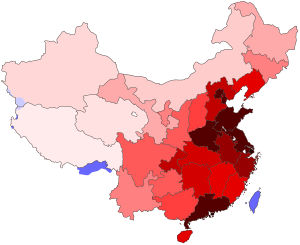 A 2010 population density map of the territories governed by the PRC and the ROC. The eastern, coastal provinces are much more densely populated than the western interior because of the historical access to water. |
| ||||||||||||||||||||||||||||||||||||||||||
Language issues in China
There are several hundred languages in China. The predominant language is Standard Chinese, which is based on central Mandarin, but there are hundreds of related Chinese languages, collectively known as Hanyu (simplified Chinese: 汉语; traditional Chinese: 漢語; pinyin: Hànyǔ, 'Han language'), that are spoken by 92% of the population. The Chinese (or 'Sinitic') languages are typically divided into seven major language groups, and their study is a distinct academic discipline.[4] They differ as much from each other morphologically and phonetically as do English, German and Danish. There are in addition approximately 300 minority languages spoken by the remaining 8% of the population of China.[5] The ones with greatest state support are Mongolian, Tibetan, Uyghur and Zhuang.
Cantonese is a variety of Chinese spoken in the city of Guangzhou (also known as Canton) and its surrounding area in southeastern China. It is the traditional prestige variety and standard form of Yue Chinese, one of the major subgroups of Chinese. Mandarin Chinese as their first language, accounting for 71% of the country's population.[6]
Summary of varieties of Chinese

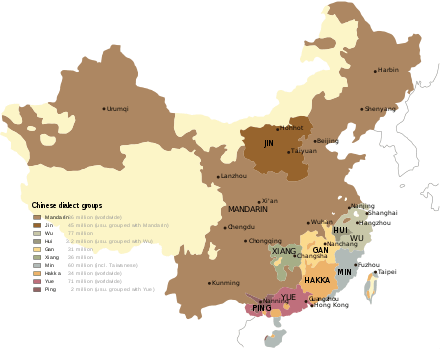
The number of speakers derived from statistics or estimates (2019) and were rounded:[7][8][9]
| Number | Branch | Native Speakers | Dialects |
|---|---|---|---|
| 1 | Mandarin | 850,000,000 | 51 |
| 2 | Wu | 95,000,000 | 37 |
| 3 | Yue | 80,000,000 | 52 |
| 4 | Jin | 70,000,000 | 6 |
| 5 | Min | 60,000,000 | 61 |
| 6 | Hakka | 55,000,000 | 10 |
| 7 | Xiang | 50,000,000 | 25 |
| 8 | Gan | 30,000,000 | 9 |
| 9 | Huizhou | 7,000,000 | 13 |
| 10 | Pinghua | 3,000,000 | 2 |
| Total | Chinese | 1,300,000,000 | 266 |
Mandarin
- 官话/官話
The number of speakers derived from statistics or estimates (2019) and were rounded:[10]
| Number | Branch | Native Speakers | Dialects |
|---|---|---|---|
| 1 | Beijing | 35,000,000 | 7 |
| 2 | Ji–Lu | 110,000,000 | 4 |
| 3 | Jianghuai | 80,000,000 | 6 |
| 4 | Jiao–Liao | 35,000,000 | 4 |
| 5 | Lan–Yin | 10,000,000 | 3 |
| 6 | Northeastern | 100,000,000 | 4 |
| 7 | Southwestern | 280,000,000 | 11 |
| 8 | Zhongyuan | 200,000,000 | 11 |
| Total | Mandarin | 850,000,000 | 50 |
Summary of Han Chinese
The number of speakers derived from statistics or estimates (2019) and were rounded:[11][12][13]
History
Racial and Ethnic Conflicts in Imperial China
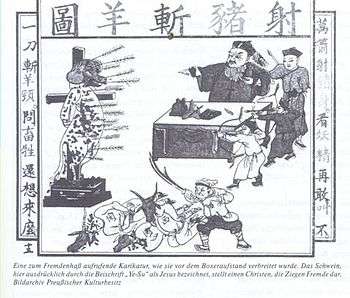
Racial slurs by the ruling Han Chinese in imperial China has been documented in historical texts such as Yan Shigu's commentary on the Book of Han, in which the Wusun people were called "barbarians who have green eyes and red hair" and compared to macaques.[14]
Some ethnic conflicts were violent. During the 350 AD Wei–Jie war, the Han Chinese leader Ran Min massacred non-Chinese Wu Hu in retaliation for abuses against the Chinese population; the Jie people were particularly affected.[15] Rebels slaughtered Arab and Persian merchants in the Yangzhou massacre (760). According to Arab historian Abu Zayd Hasan of Siraf, the rebel Huang Chao's army killed Arab, Jewish, Christian, and Parsi merchants in the Guangzhou massacre when he captured Guang Prefecture.[16] Arabs and Persians living in Quanzhou were massacred in the Ispah rebellion.
Widespread violence against the Manchu people by Han Chinese rebels occurred during the Xinhai Revolution, most notably in Xi'an (where the Manchu quarter's population—20,000—was killed) and Wuhan (where 10,000 Manchus were killed).[17] Some scholars claim that the Manchus were seen as uncivilized and lacking culture, adopting Han Chinese and Tibetan culture instead.
Race, Class, and Ethnic Conflicts
The Mongols divided groups into a four-class caste system during the Yuan dynasty. Merchants and non-Mongol overseers were usually immigrants or local ethnic groups: Turkestani and Persian Muslims and Christians. Foreigners from outside the Mongol Empire, such as the Polo family, were welcomed.
Despite the Muslims' high position, the Yuan Mongols discriminated against them: restricting halal slaughter and other Islamic practices, such as circumcision (and kosher butchering for Jews). Genghis Khan called Muslims "slaves".[18][19] Muslim generals eventually joined the Han Chinese in rebelling against the Mongols. Ming dynasty founder Zhu Yuanzhang had Muslim generals (including Lan Yu) who rebelled against the Mongols and defeated them in battle. Semu-caste Muslims revolted against the Yuan dynasty in the Ispah rebellion, although the rebellion was crushed and the Muslims massacred by Yuan commander Chen Youding. Uyghur leader Sabit Damulla Abdulbaki said about the Han Chinese and Tungans (Hui Muslims):
The Tungans, more than the Han, are the enemy of our people. Today our people are already free from the oppression of the Han, but still continue under Tungan subjugation. We must still fear the Han, but cannot fear the Tungans also. The reason we must be careful to guard against the Tungans, we must intensely oppose, cannot afford to be polite. Since the Tungans have compelled us, we must be this way. Yellow Han people have not the slightest thing to do with Eastern Turkestan. Black Tungans also do not have this connection. Eastern Turkestan belongs to the people of Eastern Turkestan. There is no need for foreigners to come be our fathers and mothers ... From now on we do not need to use foreigners language, or their names, their customs, habits, attitudes, written language, etc. We must also overthrow and drive foreigners from our boundaries forever. The colors yellow and black are foul. They have dirtied our land for too long. So now it is absolutely necessary to clean out this filth. Take down the yellow and black barbarians! Long live Eastern Turkestan!"[20][21]
An American telegram reported that Uyghur groups in parts of Xinjiang demanded the expulsion of White Russians and Han Chinese from Xinjiang during the Ili Rebellion. The Uyghurs reportedly said, "We freed ourselves from the yellow men, now we must destroy the white". According to the telegram, "Serious native attacks on people of other races frequent. White Russians in terror of uprising."[22]
Tensions erupted between Muslim sects, ethnic groups, the Tibetans and Han Chinese during the late 19th century near Qinghai.[23] According to volume eight of the Encyclopædia of Religion and Ethics, the Muslim Dungan and Panthay revolts were ignited by racial antagonism and class warfare.[24]
The Ush rebellion in 1765 by Uyghur Muslims against the Manchus occurred after Uyghur women were gang raped by the servants and son of Manchu official Su-cheng.[25][26][27] It was said that Ush Muslims had long wanted to sleep on [Sucheng and son's] hides and eat their flesh. because of the rape of Uyghur Muslim women for months by the Manchu official Sucheng and his son.[28] The Manchu Emperor ordered that the Uyghur rebel town be massacred, the Qing forces enslaved all the Uyghur children and women and slaughtered the Uyghur men.[29] Manchu soldiers and Manchu officials regularly having sex with or raping Uyghur women caused massive hatred and anger by Uyghur Muslims to Manchu rule. The invasion by Jahangir Khoja was preceded by another Manchu official, Binjing who raped a Muslim daughter of the Kokan aqsaqal from 1818–1820. The Qing sought to cover up the rape of Uyghur women by Manchus to prevent anger against their rule from spreading among the Uyghurs.[30]
The Manchu official Shuxing'a started an anti-Muslim massacre which led to the Panthay Rebellion. Shuxing'a developed a deep hatred of Muslims after an incident where he was stripped naked and nearly lynched by a mob of Muslims. He ordered several Hui Muslim rebels to be slow sliced to death.[31][32]
The Hui Muslim community was divided in its support for the 1911 Xinhai Revolution. The Hui Muslims of Shaanxi supported the revolutionaries and the Hui Muslims of Gansu supported the Qing. The native Hui Muslims (Mohammedans) of Xi'an (Shaanxi province) joined the Han Chinese revolutionaries in slaughtering the entire 20,000 Manchu population of Xi'an.[33][34][35] The native Hui Muslims of Gansu province led by general Ma Anliang sided with the Qing and prepared to attack the anti-Qing revolutionaries of Xi'an city. Only some wealthy Manchus who were ransomed and Manchu females survived. Wealthy Han Chinese seized Manchu girls to become their slaves[36] and poor Han Chinese troops seized young Manchu women to be their wives.[37] Young pretty Manchu girls were also seized by Hui Muslims of Xi'an during the massacre and brought up as Muslims.[38]
Modern China
Anti-Japanese sentiment
Anti-Japanese sentiment primarily stems from Japanese war crimes which were committed during the Second Sino-Japanese War. History-textbook revisionism in Japan and the denial (or whitewashing) of events such as the Nanking Massacre by the whole Japanese people has continued to inflame anti-Japanese feeling in China. It has been alleged that anti-Japanese sentiment is also partially the result of political manipulation by the Communist Party.[39] According to a BBC report, anti-Japanese demonstrations received tacit approval from Chinese authorities (although Chinese ambassador to Japan Wang Yi said that the Chinese government does not condone such protests).[40]
Conflict with Uyghurs
A Uyghur proverb says, "Protect religion, Kill the Han and destroy the Hui" (baohu zongjiao, sha Han mie Hui 保護宗教,殺漢滅回),[21][41] and anti-Hui poetry was written by Uyghurs:[42]
In Bayanday there is a brick factory,
it had been built by the Chinese.
If the Chinese are killed by soldiers,
the Tungans take over the plundering.
A Uyghur would reportedly not enter a Hui mosque, and Hui and Han households were built together in a town; Uyghurs would live farther away.[42] Uyghurs have been known to view Hui Muslims from other provinces of China as hostile and threatening.[43][44][45] Mixed Han and Uyghur children are known as erzhuanzi (二转子); Uyghurs call them piryotki,[44][46] and shun them.[47]
The Chinese government and individual Han Chinese citizens have been accused of discrimination against the Uyghur minority.[48][49][50] This was a reported cause of the July 2009 Ürümqi riots, which occurred largely along racial lines. A People's Daily essay referred to the events as "so-called racial conflict",[51] and several Western media sources called them "race riots".[52][53][54] Unofficial Chinese policy reportedly denies passports to Uyghurs until they reach retirement age, especially if they intend to leave the country for the pilgrimage to Mecca.[48]
Tensions between Hui and Uyghurs arose because Qing and Republican Chinese authorities used Hui troops and officials to dominate the Uyghurs and suppress Uyghur revolts.[55] The Uyghur population grew by 1.7 percent in Xinjiang between 1940 and 1982, and the Hui population increased by 4.4 percent. Tensions have increased between Uyghur and Hui Muslims due to the population-growth disparity. The massacre of Uyghurs by Ma Zhongying's Hui troops in the Battle of Kashgar (1934) caused unease as more Hui moved into the region from other parts of China.[56]
Some Hui criticize Uyghur separatism. According to Dru C. Gladney, the Hui "don't tend to get too involved in international Islamic conflict. They don't want to be branded as radical Muslims."[57][58] Hui and Uyghurs live and worship separately.[59]
Han and Hui intermarry more than Uyghurs and Hui do, despite the latter's shared religion. Some Uyghurs believe that a marriage to a Hui is more likely to end in divorce.[60]
The Sibe tend to believe negative stereotypes of Uyghurs and identify with the Han.[61] According to David Eimer, one Han person had a negative view of Uyghurs but had a positive opinion of Tajiks in Tashkurgan.[62]
Yengisar (يېڭىسار, Йеңисар) is known for the manufacture of Uyghur handcrafted knives[63][64]—yingjisha (英吉沙刀 or 英吉沙小刀) in Chinese.[65][66][67][68][69] Although the wearing of knives by Uyghur men (indicating the wearer's masculinity) is a significant part of Uyghur culture,[70] it is seen as an aggressive gesture by others.[71] The Uyghur word for knife is pichaq (پىچاق, пичақ), and the plural is pichaqchiliq (پىچاقچىلىقى, пичақчилиқ).[72] Limitations were placed on knife vending due to terrorism and violent assaults where they were utilized.[73] Robberies and assaults committed by groups of Uighurs, including children sold to (or kidnapped by) gangs, have increased tensions.[74][75][76] China has been working on multilateral anti-terrorism since the September 11 attacks and, according to the United Nations and the U.S. Department of State, some Uyghur separatist movements have been identified as terrorist groups.[77]
Tibet
Many residents of the frontier districts of Sichuan and other Tibetan areas in China are of Han-Tibetan ethnicity, and are looked down on by Tibetans.[78] Tibetan Muslims, known as Kache in Tibetan, have lived peacefully with Tibetan Buddhists for over a thousand years because Buddhists are prohibited by their religion from killing animals but require meat to survive in their mountainous climate. However, Tibetans clash with the Hui (known as Kyangsha in Tibetan). Tibetans and Mongols refused to allow other ethnic groups (such as the Kazakhs) to participate in a ritual ceremony in Qinghai until Muslim general Ma Bufang reformed the practice.[79]
Tibetan-Muslim violence
Most Muslims in Tibet are Hui. Although hostility between Tibetans and Muslims stems from the Muslim warlord Ma Bufang's rule in Qinghai (the Ngolok rebellions (1917–49) and the Sino-Tibetan War), in 1949 the Communists ended violence between Tibetans and Muslims. However, recent Tibetan-Muslim violence occurred. Riots broke out between Muslims and Tibetans over a bone in soups and the price of balloons; Tibetans accused Muslims of being cannibals who cooked humans, attacking Muslim restaurants. Fires set by Tibetans burned the apartments and shops of Muslims, and Muslims stopped wearing their traditional headwear and began to pray in secret.[80] Chinese-speaking Hui also have problems with the Tibetan Hui (the Tibetan-speaking Kache Muslim minority).[81]
The main mosque in Lhasa was burned down by Tibetans, and Hui Muslims were assaulted by rioters in the 2008 Tibetan unrest.[82] Tibetan exiles and foreign scholars overlook sectarian violence between Tibetan Buddhists and Muslims.[83] Most Tibetans viewed the wars against Iraq and Afghanistan after the September 11 attacks positively, and anti-Muslim attitudes resulted in boycotts of Muslim-owned businesses.[84] Some Tibetan Buddhists believe that Muslims cremate their imams and use the ashes to convert Tibetans to Islam by making Tibetans inhale the ashes, although they frequently oppose proposed Muslim cemeteries.[85] Since the Chinese government supports the Hui Muslims, Tibetans attack the Hui to indicate anti-government sentiment and due to the background of hostility since Ma Bufang's rule; they resent perceived Hui economic domination.[86]
In 1936, after Sheng Shicai expelled 20,000 Kazakhs from Xinjiang to Qinghai, Hui troops led by Ma Bufang reduced the number of Kazakhs to 135.[87] Over 7,000 Kazakhs fled northern Xinjiang to the Tibetan Qinghai plateau region (via Gansu), causing unrest. Ma Bufang relegated the Kazakhs to pastureland in Qinghai, but the Hui, Tibetans and Kazakhs in the region continued to clash.[88]
In northern Tibet, Kazakhs clashed with Tibetan soldiers before being sent to Ladakh.[89] Tibetan troops robbed and killed Kazakhs at Chamdo, 400 miles (640 km) east of Lhasa, when the Kazakhs entered Tibet.[90][91] In 1934, 1935 and 1936–1938, an estimated 18,000 Kazakhs entered Gansu and Qinghai.[92] In 2017, the Dalai Lama compared the peacefulness of China's Muslims unfavorably to that of their Indian counterparts.[93]
Other ethnic groups
Scholars have noted that the People's Republic of China largely portrays racism as a Western phenomenon which has led to a lack of acknowledgement of racism in its own society.[94][95][96] For example, the UN Committee on the Elimination of Racial Discrimination reported in 2018 that Chinese law does not define "racial discrimination."[97] In modern times, this has manifested frequently as discrimination against Africans such as the Nanjing anti-African protests and intensified police action against Africans in Guangzhou.[98][99] Reports of racism against Africans in China grew during the COVID-19 pandemic in mainland China.[100][101][102]
A Hui soldier from the 36th Division called Swedish explorer Sven Hedin a "foreign devil",[103][104] and Tungans were reportedly "strongly anti-Japanese".[105] During the 1930s, a White Russian driver for Nazi agent Georg Vasel in Xinjiang was afraid to meet Hui general Ma Zhongying, saying: "You know how the Tungans hate the Russians." Vasel passed the Russian driver off as a German.[106]
A Chinese Muslim general encountered by writer Peter Fleming thought that his visitor was a foreign "barbarian" until he learned that Fleming's outlook was Chinese.[107] Fleming saw a Uyghur grovel at the general's feet, and other Uighurs were treated contemptuously by his soldiers.[107][108] Racial slurs were allegedly used by the Chinese Muslim troops against Uyghurs.[109] Ma Qi's Muslim forces ravaged the Labrang Monastery over an eight-year period.[110][111]
Ethnic slurs
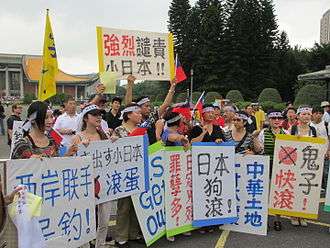
- 鬼子 (guǐzi) – "Guizi", devils, refers to foreigners
- 日本鬼子 (rìběn guǐzi) – literally "Japanese devil", used to refer to Japanese, can be translated as Jap. In 2010 Japanese internet users on 2channel created the fictional moe character Hinomoto Oniko (日本鬼子) which refers to the ethnic term, with Hinomoto Oniko being the Japanese kun'yomi reading of the Han characters "日本鬼子".[112]
- 二鬼子 (èr guǐzi) – literally "second devil", used to refer to Korean soldiers who were a part of the Japanese army during the Sino-Japanese war in World War II.[113]
- 毛子 (máo zi) – literally "body hair" – a derogatory term for Caucasians. However, because most white people in contact with China were Russians before the 19th century, 毛子 became a derogatory term for Russians.[114][115]
According to historian Frank Dikötter,
A common historical response to serious threats directed towards a symbolic universe is "nihilation", or the conceptual liquidation of everything inconsistent with official doctrine. Foreigners were labelled "barbarians" or "devils", to be conceptually eliminated. The official rhetoric reduced the Westerner to a devil, a ghost, an evil and unreal goblin hovering on the border of humanity. Many texts of the first half of the nineteenth century referred to the English as "foreign devils" (yangguizi), "devil slaves" (guinu), "barbarian devils" (fangui), "island barbarians" (daoyi), "blue-eyed barbarian slaves" (biyan yinu), or "red-haired barbarians" (hongmaofan).[116]
- Xiao Riben (小日本 Small Japanese)
- 鬼佬 – Gweilo, literally "ghostly man" (directed at white Westerners)
- 黑鬼 (hei guǐ) – "Black devil" (directed at Africans).[117]
- 妖精 – "Demons", used against Manchu people by the Taipings[118]
- 阿三 (A Sae) or 紅頭阿三 (Ghondeu Asae) - Originally a Shanghainese term used against Indians, it is also used in Mandarin.[119]
- chán-tóu (纏頭; turban heads) – used during the Republican period against Uyghurs[109][120]
- nǎozǐ jiǎndān (腦子簡單; simple-minded) – also used during the Republican period against Uyghurs[109]
- Erzhuanzi (二轉子) – children who are mixed Uyghur and Han[44][46] The term was said by European explorers in the 19th century to refer to a people descended from Chinese, Taghliks, and Mongols living in the area from Ku-ch'eng-tze to Barköl in Xinjiang.[121]
- lǜlǜ (綠綠 Green Green) – used to disparage Muslims as green is considered a holy colour in the Muslim faith.
- Gaoli bangzi (高麗棒子 Korean Stick) - Used against Koreans, does not matter North Korean or South Korean.
Etymology and Ethnic Biases
Chinese orthography provides opportunities to write ethnic insults logographically. Some Chinese characters used to transcribe the names of non-Chinese peoples were graphically-pejorative ethnic slurs, where the insult was not the Chinese word but the character used to write it. For example, the name of the Yao people was transcribed as 猺, a character which also means "jackal" and is written with the dog radical 犭. Being called a dog is a pejorative term in China. This name for the Yao, developed by 11th-century Song dynasty authors, has been replaced twice in 20th-century language reforms: with the invented character yao 傜 (with the human radical 亻) and with yao 瑤 (with the jade radical 玉), which can also mean "precious jade". Although the characters have the same pronunciation, they have different radicals (which convey different meanings).
See also
Notes
- "China". CIA. Retrieved 2007-04-24.
- Jemimah Steinfeld, 25 May 2012, Mood darkens in Beijing amid crackdown on 'illegal foreigners', CNN
- 15 May 2012, Beijing Pledges to ‘Clean Out’ Illegal Foreigners, China Real Time Report, Wall Street Journal
- Dwyer, Arienne (2005). The Xinjiang Conflict: Uyghur Identity, Language Policy, and Political Discourse (PDF). Political Studies 15. Washington: East-West Center. pp. 31–32. ISBN 978-1-932728-29-3.
Tertiary institutions with instruction in the languages and literatures of the regional minorities (e.g., Xinjiang University) have faculties entitled Hanyu xi ("Languages of China Department") and Hanyu wenxue xi ("Literatures of the Languages of China Department").
- Languages of China – from Lewis, M. Paul (ed.), 2009. Ethnologue: Languages of the World, Sixteenth edition. Dallas, Tex.: SIL International. "The number of individual languages listed for China is 299. "
- Mikael Parkvall, "Världens 100 största språk 2007" (The World's 100 Largest Languages in 2007), in Nationalencyklopedin. Asterisks mark the 2010 estimates for the top dozen languages.
- https://www.ethnologue.com/
- https://glottolog.org/glottolog/family
- https://www.ethnologue.com/subgroups/chinese
- https://www.ethnologue.com/subgroups/chinese
- https://www.chinadaily.com.cn/ethnic/2009-08/18/content_8582984.htm
- https://www.ethnologue.com/
- http://www.davidpbrown.co.uk/help/top-100-languages-by-population.html
- Book of Han, with commentary by Yan Shigu Original text: 烏孫於西域諸戎其形最異。今之胡人青眼、赤須,狀類彌猴者,本其種也。
- Mark Edward Lewis (2009). China between empires: the northern and southern dynasties. Harvard University Press. p. 76. ISBN 978-0-674-02605-6. Retrieved 2010-06-28.
ran min non chinese.
- Gabriel Ferrand, ed. (1922). Voyage du marchand arabe Sulaymân en Inde et en Chine, rédigé en 851, suivi de remarques par Abû Zayd Hasan (vers 916). p. 76.
- Rhoads, Edward J. M. (2000). Manchus and Han: Ethnic Relations and Political Power in Late Qing and Early Republican China, 1861–1928. University of Washington Press. ISBN 9780295980409.
- Michael Dillon (1999). China's Muslim Hui community: migration, settlement and sects. Richmond: Curzon Press. p. 24. ISBN 0-7007-1026-4. Retrieved 2010-06-28.
- Johan Elverskog (2010). Buddhism and Islam on the Silk Road. University of Pennsylvania Press. pp. 229, 230. ISBN 0-8122-4237-8. Retrieved 2010-06-28.
- Zhang, Xinjiang Fengbao Qishinian [Xinjiang in Tumult for Seventy Years], 3393-4.
- The Islamic Republic of Eastern Turkestan and the Formation of Modern Uyghur Identity in Xinjiang, by JOY R. LEE
- UNSUCCESSFUL ATTEMPTS TO RESOLVE POLITICAL PROBLEMS IN SINKIANG; EXTENT OF SOVIET AID AND ENCOURAGEMENT TO REBEL GROUPS IN SINKIANG; BORDER INCIDENT AT PEITASHAN
- Nietupski (1999), p. 82
- James Hastings; John Alexander Selbie; Louis Herbert Gray (1916). Encyclopædia of religion and ethics, Volume 8. T. & T. Clark. p. 893. Retrieved 2010-11-28.
- Millward, James A. (1998). Beyond the Pass: Economy, Ethnicity, and Empire in Qing Central Asia, 1759-1864. Stanford University Press. p. 124. ISBN 0804797927.
- Newby, L. J. (2005). The Empire And the Khanate: A Political History of Qing Relations With Khoqand C1760-1860 (illustrated ed.). BRILL. p. 39. ISBN 9004145508.
- Wang, Ke (2017). "Between the "Ummah" and "China":The Qing Dynasty's Rule over Xinjiang Uyghur Society" (PDF). Journal of Intercultural Studies. Kobe University. 48: 204.
- Millward, James A. (2007). Eurasian Crossroads: A History of Xinjiang (illustrated ed.). Columbia University Press. p. 108. ISBN 978-0231139243.
- Millward, James A. (2007). Eurasian Crossroads: A History of Xinjiang (illustrated ed.). Columbia University Press. p. 109. ISBN 978-0231139243.
- Millward, James A. (1998). Beyond the Pass: Economy, Ethnicity, and Empire in Qing Central Asia, 1759-1864. Stanford University Press. pp. 206–207. ISBN 0804797927.
- Atwill, David G. (2005). The Chinese Sultanate: Islam, Ethnicity, and the Panthay Rebellion in Southwest China, 1856-1873 (illustrated ed.). Stanford University Press. p. 89. ISBN 0804751595.
- Wellman, Jr., James K., ed. (2007). Belief and Bloodshed: Religion and Violence across Time and Tradition. Rowman & Littlefield Publishers. p. 121. ISBN 978-0742571341.
- Backhouse, Sir Edmund; Otway, John; Bland, Percy (1914). Annals & Memoirs of the Court of Peking: (from the 16th to the 20th Century) (reprint ed.). Houghton Mifflin. p. 209.
- The Atlantic, Volume 112. Atlantic Monthly Company. 1913. p. 779.
- The Atlantic Monthly, Volume 112. Atlantic Monthly Company. 1913. p. 779.
- Rhoads, Edward J. M. (2000). Manchus and Han: Ethnic Relations and Political Power in Late Qing and Early Republican China, 1861–1928 (illustrated, reprint ed.). University of Washington Press. p. 192. ISBN 0295980400.
- Rhoads, Edward J. M. (2000). Manchus and Han: Ethnic Relations and Political Power in Late Qing and Early Republican China, 1861–1928 (illustrated, reprint ed.). University of Washington Press. p. 193. ISBN 0295980400.
- Fitzgerald, Charles Patrick; Kotker, Norman (1969). Kotker, Norman (ed.). The Horizon history of China (illustrated ed.). American Heritage Pub. Co. p. 365.
- Shirk, Susan (2007-04-05). "China: Fragile Superpower: How China's Internal Politics Could Derail its Peaceful Rise". Archived from the original on 2007-07-07. Retrieved 2007-07-29.
- "China's anti-Japan rallies spread". BBC News. 2005-04-10.
- Robyn R. Iredale; Naran Bilik; Fei Guo (2003). China's minorities on the move: selected case studies. M.E. Sharpe. p. 170. ISBN 0-7656-1023-X. Retrieved 2010-07-30.
- Ildikó Bellér-Hann (2008). Community matters in Xinjiang, 1880-1949: towards a historical anthropology of the Uyghur. BRILL. p. 75. ISBN 978-90-04-16675-2. Retrieved 2010-06-28.
- Yangbin Chen (2008). Muslim Uyghur students in a Chinese boarding school: social recapitalization as a response to ethnic integration. Rowman & Littlefield. p. 130. ISBN 978-0-7391-2112-2. Retrieved 2010-07-30.
- David Westerlund; Ingvar Svanberg (1999). Islam outside the Arab world. Palgrave Macmillan. p. 204. ISBN 0-312-22691-8. Retrieved 2010-07-30.
- Rudelson, Justin Jon; Rudelson, Justin Ben-Adam (1997). Oasis Identities: Uyghur Nationalism Along China's Silk Road (illustrated ed.). Columbia University Press. p. 63. ISBN 0231107862. Retrieved 24 April 2014.CS1 maint: ref=harv (link)
- Ildikó Bellér-Hann (2007). Situating the Uyghurs between China and Central Asia. Ashgate Publishing, Ltd. p. 223. ISBN 978-0-7546-7041-4. Retrieved 2010-07-30.
- Justin Ben-Adam Rudelson; Justin Jon Rudelson (1997). Oasis identities: Uyghur nationalism along China's Silk Road. Columbia University Press. p. 86. ISBN 0-231-10786-2. Retrieved 2010-07-30.
- "No Uighurs Need Apply". The Atlantic. 10 Jul 2009. Retrieved 12 July 2009.
- "Uighurs blame 'ethnic hatred'". Al Jazeera. July 7, 2009. Retrieved 12 July 2009.
- "Ethnic Minorities, Don't Make Yourself at Home". The Economist. 15 January 2015.
- Global Times (10 July 2009). "People's Daily criticizes double standards in Western media attitudes to 7.5 incident". China News Wrap. Archived from the original on 19 July 2009. Retrieved 13 July 2009. original article in Chinese
- "Race Riots Continue in China's Far West". Time magazine. 2009-07-07. Retrieved 13 July 2009.
- "Deadly race riots put spotlight on China". The San Francisco Chronicle. July 8, 2009. Retrieved 13 July 2009.
- "Three killed in race riots in western China". The Irish Times. July 6, 2009. Retrieved 13 July 2009.
- Starr (2004), p. 311
- S. Frederick Starr (2004). Xinjiang: China's Muslim borderland. M.E. Sharpe. p. 113. ISBN 0-7656-1318-2. Retrieved 2010-06-28.
- Van Wie Davis, Elizabath. "Uyghur Muslim Ethnic Separatism in Xinjiang, China". Asia-Pacific Center for Security Studies. Retrieved 2010-06-28.
- Yardley, Jim (Feb 16, 2006). "China's Muslims remain quiet". The Tuscaloosa News. p. 9A.
- Safran, William (1998). Nationalism and ethnoregional identities in China. Psychology Press. p. 35. ISBN 0-7146-4921-X. Retrieved 2011-01-11.
- Finley, Joanne N. Smith (2013). The Art of Symbolic Resistance: Uyghur Identities and Uyghur-Han Relations in Contemporary Xinjiang (illustrated ed.). BRILL. p. 337. ISBN 978-9004256781. Retrieved 24 April 2014.CS1 maint: ref=harv (link)
- Rachel Harris (23 December 2004). Singing the Village: Music, Memory and Ritual Among the Sibe of Xinjiang. OUP/British Academy. pp. 45–. ISBN 978-0-19-726297-9.
- David Eimer (14 August 2014). The Emperor Far Away: Travels at the Edge of China. A&C Black. pp. 70–. ISBN 978-1-4088-1322-5.
- China. Eye Witness Travel Guides. p. 514.
- "Two Weeks Wild scenery of Xinjiang - Silk Road Tours China". Archived from the original on 2015-12-08.
- "新疆的英吉沙小刀(组图)". china.com.cn. Archived from the original on December 19, 2013.
- "The Uyghur Nationality". Oriental Nationalities. Archived from the original on 2014-05-20.
- "英吉沙小刀".
- "Loving Nanjiang 15 days - Sichuan, China Youth Travel Service".
- wangyuliang. "Specialties and Sports of the Uyghur Ethnic Minority".
- "英吉沙小刀". sinobuy.cn. Archived from the original on 2015-11-09.
- "Kunming attack further frays ties between Han and Uighurs". TODAYonline.
- "شىنجاڭ دېھقانلار تورى". Archived from the original on 2015-12-08. Retrieved 2016-08-13.
- Makinen, Julie (17 September 2014). "For China's Uighurs, knifings taint an ancient craft". Los Angeles Times. Archived from the original on 16 October 2015. Retrieved 31 March 2018.
- Jacobs, Andrew (3 March 2014). "Train Station Rampage Further Strains Ethnic Relations in China". The New York Times. Retrieved 31 March 2018.
- Demick, Barbara (21 August 2011). "China's Uighur petitioners face abuse in Beijing". Los Angeles Times. Retrieved 31 March 2018.
- "China tightens adoption rules to fight child trafficking". The Guardian. Associated Press. 16 August 2011. Retrieved 31 March 2018.
- Wayne, Martin I. (2008). China's war on terrorism counter- insurgency, politics, and internal security (1. publ. ed.). Milton Park, Abingdon, Oxon: Routledge. ISBN 978-0203936139.
- Friedrich Ratzel (1898). The history of mankind, Volume 3. Macmillan and co., ltd. p. 355. Retrieved 2010-07-30.
- Uradyn Erden Bulag (2002). Dilemmas The Mongols at China's edge: history and the politics of national unity. Rowman & Littlefield. p. 54. ISBN 0-7425-1144-8. Retrieved 2010-06-28.
- Demick, Barbara (23 June 2008). "Tibetan-Muslim tensions roil China". Los Angeles Times. Archived from the original on June 22, 2010. Retrieved 2010-06-28.
- Mayaram, Shail (2009). The other global city. Taylor Francis US. p. 75. ISBN 978-0-415-99194-0. Retrieved 2010-07-30.
- "Police shut Muslim quarter in Lhasa". CNN. LHASA, Tibet. 28 March 2008. Archived from the original on April 4, 2008.
- Fischer (2005), pp. 1–2
- Fischer (2005), p. 17
- Fischer (2005), p. 19
- A.A. (Nov 11, 2012). "The living picture of frustration". The Economist. Retrieved 2014-01-15.
- American Academy of Political and Social Science (1951). The Annals of the American Academy of Political and Social Science, Volume 277. American Academy of Political and Social Science. p. 152. Retrieved 2012-09-29.
A group of Kazakhs, originally numbering over 20000 people when expelled from Sinkiang by Sheng Shih-ts'ai in 1936, was reduced, after repeated massacres by their Chinese coreligionists under Ma Pu-fang, to a scattered 135 people.
- Lin (2011), p. 112,
- Lin (2011), p. 231,
- Blackwood's Magazine. William Blackwood. 1948. p. 407.
- https://www.academia.edu/4534001/STUDIES_IN_THE_POLITICS_HISTORY_AND_CULTURE_OF_TURKIC_PEOPLES page 192
- Linda Benson (1988). The Kazaks of China: Essays on an Ethnic Minority. Ubsaliensis S. Academiae. p. 195. ISBN 978-91-554-2255-4.
- "Indian Muslims are peace loving: Dalai lama". The Times Of India. Hyderabad. Feb 12, 2017.
- Sautman, Barry (1994). "Anti-Black Racism in Post-Mao China". The China Quarterly. 138 (138): 413–437. doi:10.1017/S0305741000035827. ISSN 0305-7410. JSTOR 654951.
- "China portrays racism as a Western problem". The Economist. 2018-02-22. ISSN 0013-0613. Retrieved 2019-06-08.
- Huang, Guangzhi (2019-03-01). "Policing Blacks in Guangzhou: How Public Security Constructs Africans as Sanfei". Modern China. 45 (2): 171–200. doi:10.1177/0097700418787076. ISSN 0097-7004.
- "Committee on the Elimination of Racial Discrimination reviews the report of China". www.ohchr.org. August 13, 2018. Retrieved 2019-06-09.
- Marsh, Jenni (September 26, 2016). "The African migrants giving up on the Chinese dream". CNN. Retrieved 2019-07-14.
- Chiu, Joanna (March 30, 2017). "China has an irrational fear of a "black invasion" bringing drugs, crime, and interracial marriage". Quartz. Retrieved April 10, 2020.
- Shikanda, Hellen; Okinda, Brian (April 10, 2020). "Outcry as Kenyans in China hit by wave of racial attacks". Daily Nation. Retrieved April 10, 2020.
- "'They deny us everything': Africans under attack in China". BBC. Retrieved 2020-04-10.
- "Coronavirus: Africans in China subjected to forced evictions, arbitrary quarantines and mass testing". Hong Kong Free Press. Agence France-Presse. April 12, 2020. Retrieved April 12, 2020.
- Sven Hedin; Folke Bergman; Gerhard Bexell; Birger Bohlin; Gösta Montell (1945). History of the expedition in Asia, 1927-1935, Part 3. Göteborg, Elanders boktryckeri aktiebolag. p. 78. Retrieved 2010-06-28.
- Francis Hamilton Lyon, Sven Hedin (1936). The flight of "Big Horse": the trail of war in Central Asia. E. P. Dutton and co., inc. p. 92. Retrieved 2010-06-28.
- Forbes (1986), p. 130
- Georg Vasel; Gerald Griffin (1937). My Russian jailers in China. Hurst & Blackett. p. 143. Retrieved 2010-06-28.
- Peter Fleming (1999). News from Tartary: A Journey from Peking to Kashmir. Evanston Illinois: Northwestern University Press. p. 308. ISBN 0-8101-6071-4.
- Christian Tyler (2004). Wild West China: the taming of Xinjiang. New Brunswick, New Jersey: Rutgers University Press. p. 265. ISBN 0-8135-3533-6. Retrieved 2010-06-28.
- Forbes (1986), p. 307
- James Tyson; Ann Tyson (1995). Chinese awakenings: life stories from the unofficial China. Westview Press. p. 123. ISBN 0-8133-2473-4. Retrieved 2010-06-28.
- Nietupski (1999), p. 90
- "萌系日本鬼子 反攻中國". Liberty Times. November 1, 2010. Archived from the original on November 3, 2010. Retrieved 2012-09-29.
- 第一滴血──從日方史料還原平型關之戰日軍損失 (6) News of the Communist Party of China December 16, 2011
- 2012-05-02, 中俄军演刚结束:毛子这举动让北京狼狈不堪! Archived 2012-06-15 at the Wayback Machine (China-Russia military exercises conclude, the actions of Mao zi force Beijing into a dilemma), 环球视线
- 2012-08-26, 毛子告诉中国:美国佬不敢惹俄罗斯只是因为这 (Mao zi tell China: Yankees won't mess with Russia because of this), 参考啊
- Dikötter, Frank (1992). The Discourse of Race in Modern China. Stanford University Press, p. 36.
- Hooi, Alexis (2009-07-31). "The disunited colors of prejudice". China Daily. Retrieved 2009-11-24.
Even now, some Guangzhou residents might admit using the generic and derogatory term "hei gui" or "ghost" to refer to Africans in the community.
- Chin, Shunshin (2001). Taiping Rebellion. ISBN 9780765619532.
- "上海滩的"红头阿三"". Retrieved 2010-08-01.
- Garnaut, Anthony. "From Yunnan to Xinjiang:Governor Yang Zengxin and his Dungan Generals" (PDF). Pacific and Asian History, Australian National University. Archived from the original (PDF) on March 9, 2012. Retrieved 2010-07-14.
- Roerich Museum; George Roerich (2003). Journal of Urusvati Himalayan Research Institute, Volumes 1-3. Vedams eBooks (P) Ltd. p. 526. ISBN 81-7936-011-3. Retrieved 2010-06-28.
References
| Library resources about Ethnic issues in China |
- Fischer, Andrew Martin (2005). "Close encounters of an Inner-Asian kind: Tibetan–Muslim coexistence and conflict in Tibet, past and present" (PDF). CSRC Working Paper Series. Crisis States Research Centre (Working Paper no.68). Archived from the original (PDF) on January 3, 2006. Retrieved 26 September 2015.CS1 maint: ref=harv (link)
- Forbes, Andrew D. W. (1986). Warlords and Muslims in Chinese Central Asia: a political history of Republican Sinkiang 1911–1949. Cambridge, UK: Cambridge University Press. ISBN 978-0-521-25514-1.CS1 maint: ref=harv (link)
- Lin, Hsaio-ting (2011). Tibet and Nationalist China's Frontier: Intrigues and Ethnopolitics, 1928–49. UBC Press. ISBN 978-0-7748-5988-2.CS1 maint: ref=harv (link)
- Nietupski, Paul Kocot (1999). Labrang: a Tibetan Buddhist monastery at the crossroads of four civilizations. Snow Lion Publications. ISBN 1-55939-090-5.CS1 maint: ref=harv (link)
- Starr, S. Frederick (2004). Xinjiang: China's Muslim borderland. M.E. Sharpe. ISBN 0-7656-1318-2.CS1 maint: ref=harv (link)
Further reading
- Pfafman, Tessa M.; Christopher J. Carpenter; Yong Tang (2015-12-01). "The Politics of Racism: Constructions of African Immigrants in China on ChinaSMACK". Communication, Culture and Critique. 8 (4): 540–556. doi:10.1111/cccr.12098. - Published 9 May 2015
